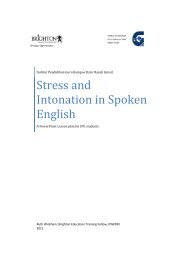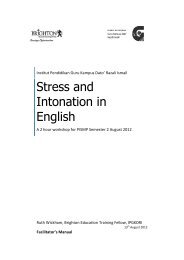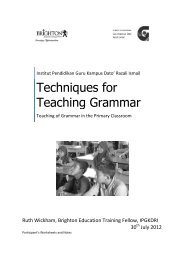Teaching English Grammar in Malaysian Primary Schools
Teaching English Grammar in Malaysian Primary Schools
Teaching English Grammar in Malaysian Primary Schools
You also want an ePaper? Increase the reach of your titles
YUMPU automatically turns print PDFs into web optimized ePapers that Google loves.
<strong>English</strong> <strong>Grammar</strong> <strong>in</strong> <strong>Malaysian</strong> <strong>Primary</strong> <strong>Schools</strong>5. Some excerpts from ELT Methodology: Pr<strong>in</strong>ciples and Practiceby Nesamalar Chitravelu, Saratha Sithamparam, and Teh Soo Choon.What is grammar? (p196)It is possible that someone who can produce perfectly correct sentences and communicateefficiently may not be able to expla<strong>in</strong> the rules of grammar. This is true of many speakers of <strong>English</strong>,<strong>in</strong>clud<strong>in</strong>g some native speakers. Such people have implicit knowledge of grammar – they knowgrammar at the level of use. One needs to have explicit knowledge of grammar to be able todescribe and expla<strong>in</strong> the rules.The place of grammar <strong>in</strong> the communicative approach (p199)The communicative approach to language learn<strong>in</strong>g focuses on gett<strong>in</strong>g students to use language tocommunicate effectively. To achieve this, teachers usually put students <strong>in</strong>to situations where theyare us<strong>in</strong>g the language not merely <strong>in</strong> response to the teacher’s <strong>in</strong>structions, but also because theyneed it to seek <strong>in</strong>formation, give <strong>in</strong>formation, solve a problem, etc. Is there a place for the teach<strong>in</strong>gof grammar <strong>in</strong> such an approach?There are different views on this issue. At one end are teachers who prefer to teach accuracy first,that is, they beg<strong>in</strong> by teach<strong>in</strong>g grammar rules and basic sentences to equip students with a soundgrammatical base on which to develop communicative stills. At the other end are teachers whoassume that given sufficient <strong>in</strong>put and opportunities to use <strong>English</strong> <strong>in</strong> purposeful communication(through communicative activities), students will eventually acquire implicit knowledge of grammar.Teachers who use the accuracy first model will probably produce students who can reproduceaccurately sentences learnt, but it is not certa<strong>in</strong> how well these students can use these sentences <strong>in</strong>real communication. Teachers who use the communication first model are likely to producestudents who are confident and fluent <strong>in</strong> communication. It is also true that there will begrammatical errors <strong>in</strong> their language use. Students who learn <strong>English</strong> through the communicationfirst model often develop the habit of us<strong>in</strong>g ungrammatical forms. And these <strong>in</strong>accurate forms maybecome fossilised, that is, they become fixed and are extremely difficult to change. This should beavoided.Our aim <strong>in</strong> teach<strong>in</strong>g <strong>English</strong> is to develop <strong>in</strong> our students both accuracy and fluency, so that weshould <strong>in</strong>clude both types of activities: activities focuss<strong>in</strong>g on grammar, and those focuss<strong>in</strong>g onfluency. There should be a balance of both types of activities to help students improve theircommunication skills.Ruth Wickham, Brighton Education Tra<strong>in</strong><strong>in</strong>g Fellow, IPGKDRI7









